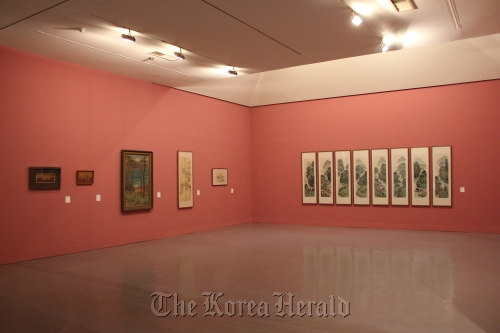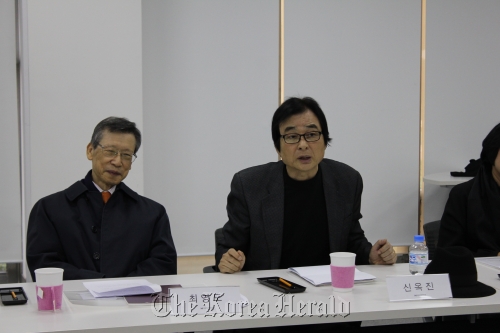Exhibition at National Museum of Contemporary Art features donated artwork; museum vows to better manage donations
The National Museum of Contemporary Art kicked off on Monday an exhibition highlighting its donors, an unprecedented move in the museum’s history.
The exhibition “Beautiful Encounter: Selected Gifts from the Collection,” currently held at MOCA in Gwacheon, Gyeonggi Province, showcases 270 among the total 3,045 donated works in the museum’s collection.
The museum also invited about 150 of their donors and directors of museums throughout the country for the “Donators’ Festival” event held that day. Choe Kwang-shik, minister of Culture, Tourism and Sports, delivered appreciation plaques to the new donors of 2011.

A view of the exhibition “Beautiful Encounter: Selected Gifts from the Collection” at the National Museum of Contemporary Art in Gwacheon, Gyeonggi Province. (MOCA)
MOCA aims to encourage contributions through the event. Donations have decreased during the last few years, according to MOCA, and donated artwork, which used to make up more than 50 percent of the museum’s total collection of 6,479 pieces, now only marks about 45 percent. Other public museum directors have also pointed out at a meeting held last month at the Press Center in central Seoul that encouraging donations is crucial to the survival of museums.
Donors, however, pointed out that as much as people are reluctant to donate, museums are not ready to receive donations either.
“It is difficult to even just make a call to say that I want to make a donation because the museum officials do not know what to do either. They are not interested if they are not responsible for the job,” said Shin Ok-jin, president of Kongkan Gallery who donated 53 pieces of art to MOCA, at a round-table talk with the press on Monday.

Shin Ok-jin, president of Kongkan Gallery, participates in a round-table talk with press members on Monday at the National Museum of Contemporary Art in Gwacheon, Gyeonggi Province. (MOCA)
He has donated about 800 works so far to different museums, valued at some 2.4 billion won in total. But the works he donated do not get the proper treatment sometimes. Once he donated a folding screen, a calligraphy work and an old painting worth about 15 million to 20 million won to a museum, but the museum did not even mark the name of the works or the artists, nor did Shin receive any kind of certificate, not that he wished for any.
“It is more meaningful to donate to small museums in the provinces because museums in Seoul or Busan are so big that the donated works just go directly into their storage vaults, not exhibition rooms. When donators give artworks, what the receiver should give in return is only honor. But Korea is too cheap on giving honors,” he said, adding that he was most happy when he was given the honorary citizen title after donating to a museum in Miryang, South Gyeongsang Province.
Choi Young-do, a lawyer who donated over 3,000 pieces of pottery to the National Museum of Korea, agreed that the beneficiaries receiving the donations have problems. Having collected about 1,600 works, he made a request to the Culture Ministry in the 1990s to build and operate a museum and he would donate all his collections, but was turned down six days later.
“I could not understand how they could turn down the offer to acquire priceless relics in only six days, probably even without holding a proper meeting about it. And there were more collectors who wanted to join in. You see, collectors have to find a way to safely manage their collections after their deaths ― leaving it to their children who do not know the value is meaningless,“ said Choi.
Fortunately the National Museum of Korea recognized the value of his collections and in 2000 requested a donation, which Choi was more than willing to accept. He continued to collect pottery and donated 1,719 more pieces until 2008.
Choi asserted that museums should better recognize donors ― such as issuing free pass cards which can be passed down in the family, setting up a hall of honor, and tax exemptions ― in order to encourage donations.
“We have felt that a change in the mindset of museum insiders was needed. We will do our best to reflect the wishes of the donors in our plan for the next year,” said Choi Eun-ju of the MOCA’s office of development.
The exhibition runs through Jan. 29 at MOCA in Gwacheon, Gyeonggi Province. Admission is free. For more information, call (02) 2188-6114 or visit www.moca.go.kr.
By Park Min-young (
claire@heraldcorp.com)






![[From the Scene] Monks, Buddhists hail return of remains of Buddhas](http://res.heraldm.com/phpwas/restmb_idxmake.php?idx=645&simg=/content/image/2024/04/19/20240419050617_0.jpg&u=20240419175937)
